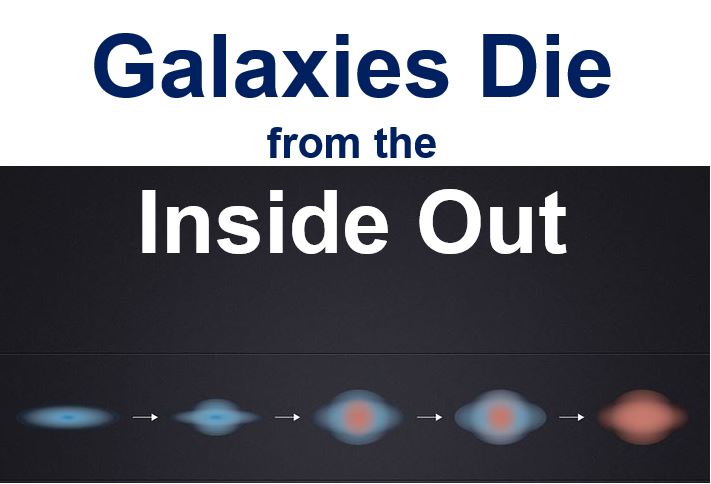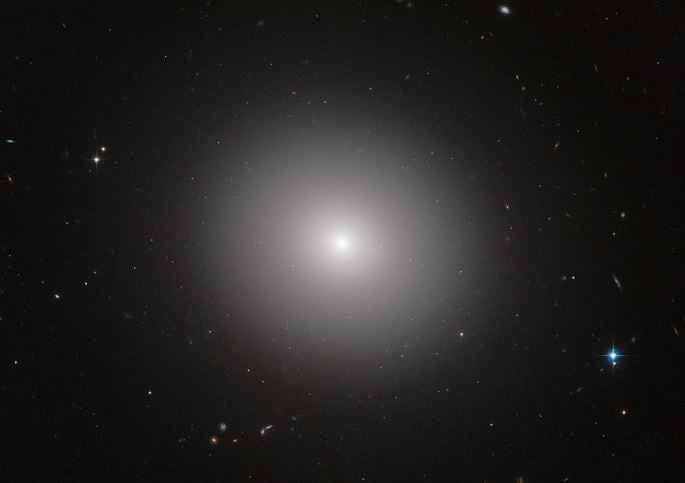Galaxy death starts when the core stops making new stars, but the outskirts continue star production, says a new release by the ESA/Hubble Information Centre. For the first time, astronomers have shown how star formation in ‘dead’ galaxies sputtered out many billions of years ago.
ESO’s Very Large Telescope (VLT) and NASA/ESA Hubble Space Telescope have revealed that about three billion years after the universe was born (Big Bang), these galaxies were still making stars in their peripheries, but not in their cores.
Star formation appears to stop in the galaxies’ cores – the quenching of star formation then spreads to the outer parts. The researchers in this latest study published their findings in the academic journal Science.

The quenching of star formation seems to have started in the cores of the galaxies and then spread to the outer parts. (Credit: ESA/Hubble and ESO)
How did massive galaxies slow down?
One of the major mysteries in astrophysics has been how massive inactive elliptical galaxies, which are common in the Universe today, quenched their once rampant rates of star formation.
Such massive galaxies, sometimes called spheroids because of their shape, generally have ten times the density of stars in their central regions compared to our Milky Way, and have about ten times our galaxy’s mass.
Astronomers refer to these massive galaxies as ‘red and dead’ because they have lots of ancient red stars, but very few younger blue stars, and show no evidence of new star formation.
The estimated ages of their red stars suggest that those galaxies stopped making new stars about ten billions years ago.
This quenching of star formation started right at the peak of the Universe’s star formation, when several galaxies were still forming stars at about twenty times today’s pace.
Massive dead spheroids have half the Universe’s stars
Lead author, Sandro Tacchella, of ETH (Eidgenössische Technische Hochschule – Swiss Federal Institute of Technology) Zurich in Switzerland, lead author of the article, said:
“Massive dead spheroids contain about half of all the stars that the Universe has produced during its entire life. We cannot claim to understand how the Universe evolved and became as we see it today unless we understand how these galaxies come to be.”

Elliptical galaxy IC 2006. (Credit: ESA/Hubble & NASA)
Tachella and team observed 22 galaxies, from an era about three billion years after the big bang, spanning a range of masses.
They used the Hubble Space Telescope’s WFC3 (Wide Field Camera 3) to look at the galaxies. The camera snapped detailed images in the near-infrared, revealing the spatial distribution of older stars within the actively star-forming galaxies.
They also used the SINFONI instrument on ESO’s Very Large Telescope to collect light from the galaxies, showing precisely where new stars were being formed.
Co-author Marcella Carollo, also of ETH Zurich, said:
“Hubble was able to show us how the stars are distributed within these galaxies in amazing detail. We were able to match this accuracy with SINFONI to find patches of star formation.”
“Using the two telescope together, we were able to explore this population of galaxies in more detail than ever before.”
Star formation stops at the core first
The new data showed that the largest galaxies in the sample maintained their steady production of new stars in their outskirts. However, in their bulging, densely packed centres, star formation had already ceased.
Alvio Renzini, Padova Observatory, who works at the Italian National Institute of Astrophysics, said:
“The newly demonstrated inside-out nature of star formation shutdown in massive galaxies should shed light on the underlying mechanisms involved, which astronomers have long debated.”
One theory suggests that star-making materials are scattered by torrents of energy by a galaxy’s central supermassive black hole as it clumsily consumes matter.
Some scientists believe fresh gas stops flowing into a galaxy, starving it of material for new stars and transforming it into a red and dead spheroid.
Co-author Natascha Förster Schreiber of the Max-Planck-Institut für extraterrestrische Physik in Garching, Germany, said:
“There are many different theoretical suggestions for the physical mechanisms that led to the death of the massive spheroids.”
“Discovering that the quenching of star formation started from the centres and marched its way outwards is a very important step towards understanding how the Universe came to look like it does now.”
The Big Bang is believed to have occurred about 13.8 billion years ago. So the galaxies Tacchella and colleagues studied are generally seen as they were over 10 billion years ago.
Citation: “Evidence for mature bulges and an inside-out quenching phase 3 billion years after the Big Bang,” S. Tacchella, C. M. Carollo, A. Renzini, N. M. Förster Schreiber, P. Lang, S. Wuyts, G. Cresci, A. Dekel, R. Genzel, S. J. Lilly, C. Mancini, S. Newman, M. Onodera, A. Shapley, L. Tacconi, J. Woo, and G. Zamorani. Science. Published 17 April, 2015 DOI:10.1126/science.1261094.

